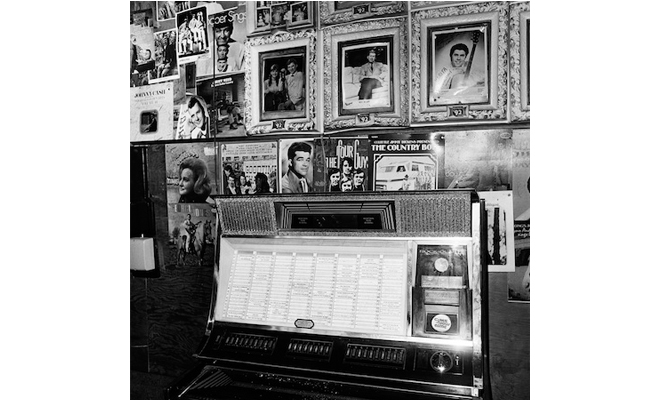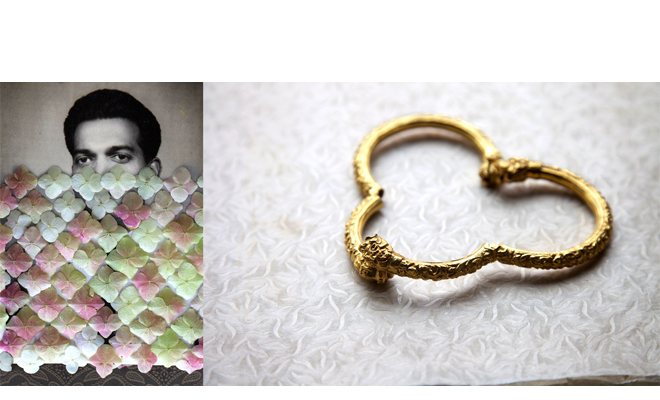Art Fly: PhotoNOLA 2012

Henry Horenstein, Jukebox, Tootsies Orchid Lounge, Nashville, Tennessee, 1972. Gelatin silver print. Courtesy the artist.
Editor's Note
Pelican Bomb's art fly, Rachel Gorman, continues to flit around town. Here she stops in on two lectures in conjunction with the recent PhotoNOLA weekend. While the talks may have come and gone, many PhotoNOLA exhibitions remain on view throughout the month and beyond. Check out the PhotoNOLA website for complete show schedules.
Like Papa Noel for the art-nerd set, the New Orleans Photo Alliance gifted New Orleans this December with their 7th annual PhotoNOLA festival: a celebration of the medium of photography through exhibits, events, and lectures in venues all over the city. Every show I attended had its own set of rewards, but the festival’s last two artist lectures packed in so many, it was like Christmas come early.
Priya Kambli led a discussion centered around “Color Falls Down,” her series currently on view in the Art Lab education gallery at the Contemporary Arts Center. Many of the CAC’s current gallery displays are dedicated to issues of mass migration, transplantation, and the nuanced experiences of immigrants themselves. Kambli’s work in “Color Falls Down,” displayed along with an interactive element asking children to explore their own familial histories, is a perfect extension of that theme. It mines Kambli’s admitted “fascination” with the intersection of her experience in the United States and her parents’ lives in India—a product of her effort to connect her children to their heritage and express the blurred but bounded edges of her dual-citizenship. Quiet and thoughtful, each work splices manipulated family portraits inherited from Kambli’s parents with her own still-life and self-portrait photographs. Together, old and new become multilayered diptychs that are, as she described them, two-dimensionally representative of a suitcase.
Walking me and 30 others from work to work, Kambli revealed the hidden meanings behind the material manipulation of her images. She pointed out her mother’s vain effort to “erase” white hair by taking a marker to an old photo now featured in Muma (Dear Suresh), 2011. That mark, Kambli felt, had become license for the artist to leave her own imprints on photographs—symbolically imbuing them, as she described, with her presence in an effort to make her works as meaningful for her children as her parents’ original photographs were for her. Looking around the room, freshly armed with her explanation, it was clear to me that the impulse had served her well—perhaps most poignantly in Baba (Muma’s Bangles), 2012, that features flower petals arranged in a pattern to partially obscure the face of her deceased father. On its own, “Color Falls Down” is an intimate exhibit full of rich texture, pattern, color, and light that recalls Indian visual traditions. After I heard Kambli discuss her process, however, the stunning series soared.
An hour later, just across the street at the Ogden, Henry Horenstein gave a more formal lecture and slideshow to a seated audience of about 45. I was (shamefully) unfamiliar with Horenstein’s work before he began to speak, but quickly realized why he had been invited to discuss his artistic legacy with the PhotoNOLA crowd. He traced his personal development as an artist, showing photos from early series like Close Relations, Honky Tonk, and Racing Days, and later works on animals, drag, and burlesque. The works were brash and Weegee-esq in their wry, frank tone and black-and-white, journalistic-style beauty.
Horenstein’s droll presentation was punctuated by absurd home videos highlighting moments of his “process.” Clips of Horenstein herding puppies or being ignored by his subjects made it clear why people seemed to be at ease in front of his lens. If he is anything like his lecture, Horenstein is unpretentious, charming, and largely motivated by a sense of fun. To hear him tell it, the photographer has spent the majority of his career as a documentarian and preservationist, building from his undergraduate training as a “bottom-up” historian to take photos of what he finds most fascinating—American pastimes and communities. He has made it his life’s work to record people whose lives might otherwise go undocumented and has in the process created a handsome body of work that brims with the spirit of populism.
Leaving PhotoNOLA’s lectures I felt flush, carrying with me a better understanding of two interesting artists who, while working with the same medium, produce radically distinct and gorgeous art. What more could an art nerd ask for?

Priya Kambli, Baba (Muma’s Bangles), 2012. Archival inkjet print. Courtesy the artist.
Editor's Note
"Priya Kambli: Color Falls Down" on view through January 20, 2013 at the Contemporary Arts Center, 900 Camp Street in New Orleans.



